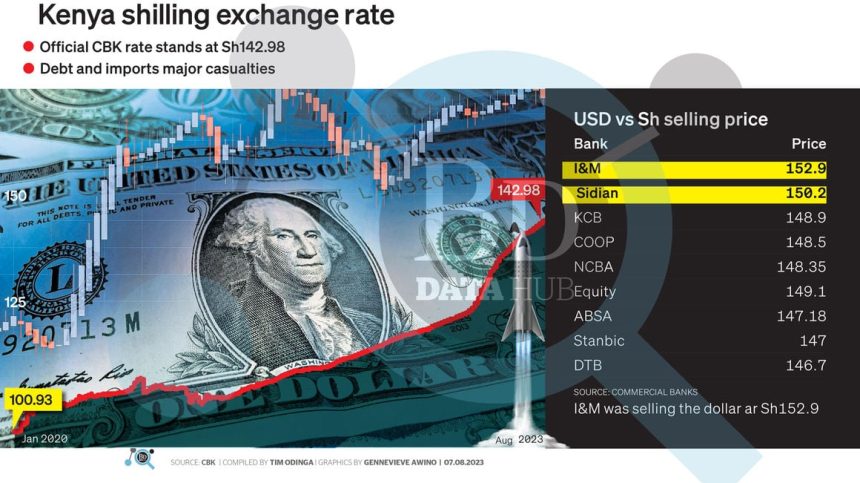The Kenyan shilling has, in one of the costliest freefalls in history, lost its value trading against the US dollar by nearly half in under 50 months, making consumers pay dearly for imported goods.
Several commercial banks are already selling US dollars above the Sh150 mark in Nairobi, piling pressure on the Kenyan shilling while setting up consumers for a new wave of currency-driven price increases across imported products including fertiliser, electronics and cars.
A spot check by the Business Daily on Monday afternoon showed the exchange rate to the dollar at I&M and Sidian Bank had breached the Sh150 mark as the country continued to grapple with a shortage of the foreign currency.
The average selling price for the dollar across 11 banks in Nairobi and three forex bureaus sampled by the Business Daily was racing towards the Sh150 mark.
The Central Bank of Kenya (CBK), however, put the average exchange rate at Sh142.98, reflecting a huge variance between the official rate and the actual trading on the ground as quoted by forex dealers.
For the other nine banks, the greenback was trading between Sh146.7 and Sh149.1 as the shilling continued to weaken despite policies that the government had put in place to arrest the freefall.
Although the Sidian Bank branch we visited did not display forex prices on the exchange rate board, a cashier told us that the tier 3 lender was buying dollars at Sh134.9 and selling at Sh150.9.
This means that Sidian Bank, which is owned by Centum Investment, raked in a net margin of Sh15.1, the widest spread among the 12 forex traders that we sampled.
A dollar fetched Sh152.9 at I&M, Sh149 at Standard Chartered Bank and Sh148.9 at KCB.
At Cooperative Bank and Stanbic, the exchange rate was at Sh148.5 and Sh147 respectively.
Absa was selling the dollar at Sh147.18 and DTB at Sh146.7.
All three forex bureaus that we sampled were selling dollars at an average of Sh145.
Kenya’s official foreign exchange reserves recently received a major boost from development partners, including the International Monetary Fund (IMF) which disbursed Sh58.6 billion ($141 million) last month.
Importers have been forced to cut their purchases even as consumers cough up more for items such as cars and electronics.
Importing a V8 car, for example, costs around $70,000. Bringing this luxury car at an exchange rate of Sh147 today would see a dealer cough up to Sh10.29 million.
A year ago, at an exchange rate of Sh105, a dealer paid Sh7.35 million. This means if you used to import 10 V8 cars, you pay an extra Sh29.4 million.
“If you don’t have that kind of money what do you do? You reduce the volumes. That is what is happening,” said Charles Munyori, the secretary-general of the Kenya Auto Bazaar Association.
“Also people are not used to that kind of pricing.”
David Kigo, an electronics dealer selling TVs, smartphones, home theatres and other electronics from China, said the sector was paying dearly for the weakening of the shilling.
“We have a finite amount of capital so a weaker shilling means you can only buy less than what you could buy previously,” said Mr Kigo.
The weakening of the exchange rate chimes with the Treasury’s projection in one of its documents.
According to the projection, the shilling could weaken further to 150.76 units against the dollar by the time it is repaying its debut Eurobond in June next year, signalling unabated pressure on the country’s exchange rate.
The report projects that the country will pay a total of Sh301,513,774,986 for a $2 billion international sovereign bond. This works out to an exchange rate of 150.76.
Trade in foreign currencies was one of the largest revenue streams for banks in 2022, thanks to the widening spread of the price at which they bought and sold foreign currencies, especially dollars.
Last year, foreign exchange income rose by at least 30 percent across the banks, with I&M leading followed by NCBA, on the back of a weakening shilling against the dollar.
President William Ruto in the past said the shilling would strengthen following the introduction of the government-to-government arrangement for oil imports aimed at providing a longer-term supply of fuel.
The President noted that the arrangement would see oil marketers pay for fuel in the local currency, easing the monthly pressure on the demand for dollars which have been in short supply.
“In fact, in my estimation, in the next couple of months, the exchange rate will come below Sh120. Maybe Sh115, you never know,” added Dr Ruto.
Nonetheless, the shilling has been on a free fall, shedding close to 15.8 percent of its value since the beginning of the year as the country continues to grapple with a dollar shortage that has been aggravated by the hike in interest rates by central banks in advanced economies.




